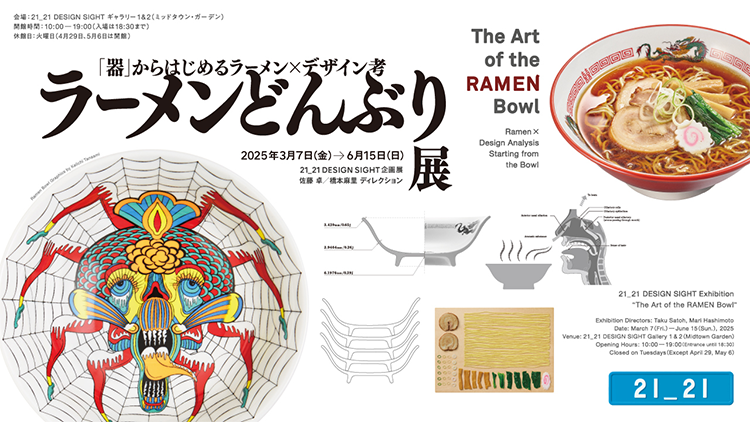SHOP | FOOD & DRINK *Business hours vary from shop to shop.
CLOSE
EVENT

The Art of the RAMEN Bowl
Mino is the general term for wares made predominantly in the western Tono region (Tajimi, Toki and Mizunami cities), where fully 90% of Japanese ramen bowls are produced. This exhibition has been developed from “The Art of the RAMEN Bowl,” which was one of a number of projects initiated in 2012, and dealing with Mino ware. The exhibition will display 40 original Artist Ramen Bowls, including 10 not previously seen, together with Ramen Stalls conceived by three groups of architects and designers. The exhibition employs the “design anatomy” method to address ramen and ramen bowls, outline the history and culture of ramen, and introduce the natural environment of the production center at Tono.
By looking from the perspective of the bowl, we hope visitors will enjoy the fascination of discovering what goes into making up the everyday ramen experience, and people and designs lying behind it.
DATE
Mar. 7 (Fri) 2025 - Jun. 15 (Sun) 2025
Place
21_21 DESIGN SIGHT Gallery 1&2
Hours
10:00~19:00
*Entrance until 18:30
Close
Tuesdays
*Except Apr. 29, May 6
Admission
General 1,600yen
University Students 800yen
High school Students 500yen
Junior high school Students and under may enter for free
*Please note that new admission charges apply from this exhibition onwards.
Contact
03-3475-2121
Others
Organized by : 21_21 DESIGN SIGHT, THE MIYAKE ISSEY FOUNDATION
Special Sponsor: Mitsui Fudosan Co., Ltd.
Support: Ceramic Valley Council
The Art of the RAMEN Bowl
Mino is the general term for wares made predominantly in the western Tono region (Tajimi, Toki and Mizunami cities), where fully 90% of Japanese ramen bowls are produced. This exhibition has been developed from “The Art of the RAMEN Bowl,” which was one of a number of projects initiated in 2012, and dealing with Mino ware. The exhibition will display 40 original Artist Ramen Bowls, including 10 not previously seen, together with Ramen Stalls conceived by three groups of architects and designers. The exhibition employs the “design anatomy” method to address ramen and ramen bowls, outline the history and culture of ramen, and introduce the natural environment of the production center at Tono.
By looking from the perspective of the bowl, we hope visitors will enjoy the fascination of discovering what goes into making up the everyday ramen experience, and people and designs lying behind it.


